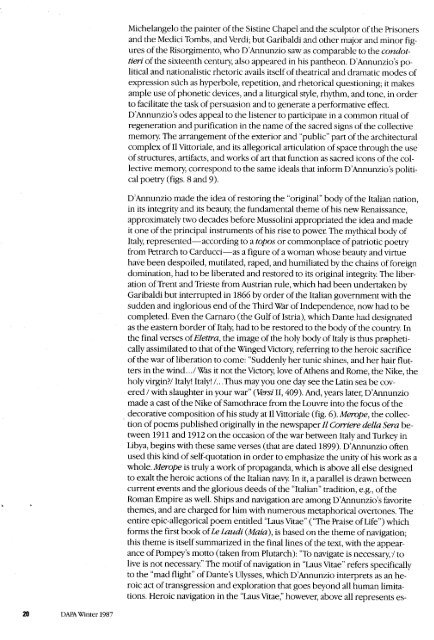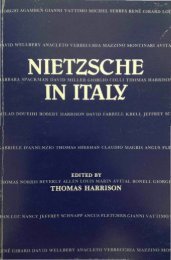The Journal of Decorative and Propaganda Arts - UCLA Department ...
The Journal of Decorative and Propaganda Arts - UCLA Department ...
The Journal of Decorative and Propaganda Arts - UCLA Department ...
You also want an ePaper? Increase the reach of your titles
YUMPU automatically turns print PDFs into web optimized ePapers that Google loves.
m DAPAWinter 1987<br />
Michelangelo the painter <strong>of</strong> the Sistine Chapel <strong>and</strong> the sculptor <strong>of</strong> the prisoners<br />
<strong>and</strong> the Medici Tombs, <strong>and</strong> Verdi; but Garibaldi <strong>and</strong> other major <strong>and</strong> minor figures<br />
<strong>of</strong> the Risorgimento, who D'Annunzio saw as comparable to the condottieri<br />
<strong>of</strong> the sixteenth century also appeared in his pantheon. D'Annunzio's political<br />
<strong>and</strong> nationalistic rhetoric avails itself <strong>of</strong> theatrical <strong>and</strong> dramatic modes <strong>of</strong><br />
expression sdch as hlperbole, repetition, <strong>and</strong> rhetorical questioning; it makes<br />
ample use <strong>of</strong> phonetic devices, <strong>and</strong> a liturgical style, rhythm, <strong>and</strong> tone, in order<br />
to facilitate the task <strong>of</strong> persuasion <strong>and</strong> to generate a performative effect.<br />
D'Annunzio's odes appeal to the listener to participate in a common ritual <strong>of</strong><br />
regeneration <strong>and</strong> purification in the name <strong>of</strong> the sacred signs <strong>of</strong> the collective<br />
memory <strong>The</strong> arrangement <strong>of</strong> the exterior <strong>and</strong> "public" pan <strong>of</strong> the architectural<br />
complex <strong>of</strong> Il Vittoriale, <strong>and</strong> its allegorical articulation <strong>of</strong> space through the use<br />
<strong>of</strong> structures, artifacts, <strong>and</strong> works <strong>of</strong> art that function as sacred icons <strong>of</strong> the collective<br />
memory correspond to the same ideals that inform D'Annunzio's political<br />
poetry (figs. 8 <strong>and</strong>9).<br />
D'Annunzio made the idea <strong>of</strong> restoring the "original" body <strong>of</strong> the Italian nation,<br />
in its integrity <strong>and</strong> its beaury the fundamental theme <strong>of</strong> his new Renaissance,<br />
approximately two decades before Mussolini appropriated the idea <strong>and</strong> made<br />
it one <strong>of</strong> the principal instruments <strong>of</strong> his rise to power. <strong>The</strong> mythical body <strong>of</strong><br />
Italy, represented-according to atopos or commonplace <strong>of</strong> patriotic poetry<br />
from Fetrarch to Carducci-as a figure <strong>of</strong> a woman whose beauty <strong>and</strong> virtue<br />
have been despoiled, mutilated, raped, <strong>and</strong> humiliated by the chains <strong>of</strong> foreign<br />
domination, had to be liberated <strong>and</strong> restored to its original integriry <strong>The</strong> liberation<br />
<strong>of</strong> Trent <strong>and</strong> Trieste from Austrian rule, which had been undertaken by<br />
Garibaldi but interrupted in 1865 by order <strong>of</strong> the Italian government with rhe<br />
sudden <strong>and</strong> inglorious end <strong>of</strong>the Third Var <strong>of</strong>lndependence, now had to be<br />
completed. Even the Carnaro (the Gulf <strong>of</strong> Istria), which Dante had designated<br />
as the eastern border <strong>of</strong> Italy, had to be restored to the body <strong>of</strong> the country In<br />
the final verses <strong>of</strong> Elema, the image <strong>of</strong> the holy body <strong>of</strong> Italy is thus prophetically<br />
assimilated to that <strong>of</strong> the '07inged Victory referring to the heroic sacrifice<br />
<strong>of</strong> the war <strong>of</strong> liberation to come: "Suddenly her tunic shines, <strong>and</strong> her hair flutters<br />
in the wind.../ \X,hs it not the Victory love <strong>of</strong>Athens <strong>and</strong> Rome, the Nike, the<br />
holy virgin?/ ltalyl ltalyl /. . . Thus may you one day see the Latin sea be covered<br />
/ with slaughter in your war" (Versi 11,409). And, years later, D'Annunzio<br />
made a cast <strong>of</strong> the Nike <strong>of</strong> Samothrace from the Louvre into the focus <strong>of</strong> the<br />
decorative composition <strong>of</strong> his study at Il Vinoriale (fig. 6). Merope, rhe collection<br />
<strong>of</strong> poems published originally in the newspaper Il Corriere della Seraberween<br />
1911 <strong>and</strong> 791,2 on the occasion <strong>of</strong> the war between Italy <strong>and</strong> Turkey in<br />
Libya, begins with these same verses (that are dated 1899). D'Annunzio <strong>of</strong>ten<br />
used this kind <strong>of</strong> self-quotation in order to emphasize the unity <strong>of</strong> his work as a<br />
whole Merope is truly a work <strong>of</strong> propag<strong>and</strong>a, which is above all else designed<br />
to exalt the heroic actions <strong>of</strong> the Italian naly In it, aparallel is drawn between<br />
current events <strong>and</strong> the glorious deeds <strong>of</strong> the "Italian" tradition, e,g., <strong>of</strong> the<br />
Roman Empire as well. Ships <strong>and</strong> navigation are among D'Annunzio's favorite<br />
themes, <strong>and</strong> are charged for him with numerous metaphorical overtones. <strong>The</strong><br />
entire epic-allegorical poem entitled "Laus Vitae" ("<strong>The</strong> Praise <strong>of</strong> Life") which<br />
forms the first book <strong>of</strong> Le l"audi (Maia), is based on rhe theme <strong>of</strong> navigation;<br />
this theme is iself summarized in the final lines <strong>of</strong> the texr, wirh the appearance<br />
<strong>of</strong> Fompey's motto (taken from Plutarch): "To navigate is necessary./ to<br />
live is not necessary" <strong>The</strong> motif <strong>of</strong> navigation in "Laus Vitae" refers specifically<br />
to the "mad flight" <strong>of</strong> Dante's Ulysses, which D Annunzio interprets as an heroic<br />
act <strong>of</strong> transgression <strong>and</strong> exploration that goes beyond all human limitations.<br />
Heroic navigation in the "LausVitae," however, above all represents es




